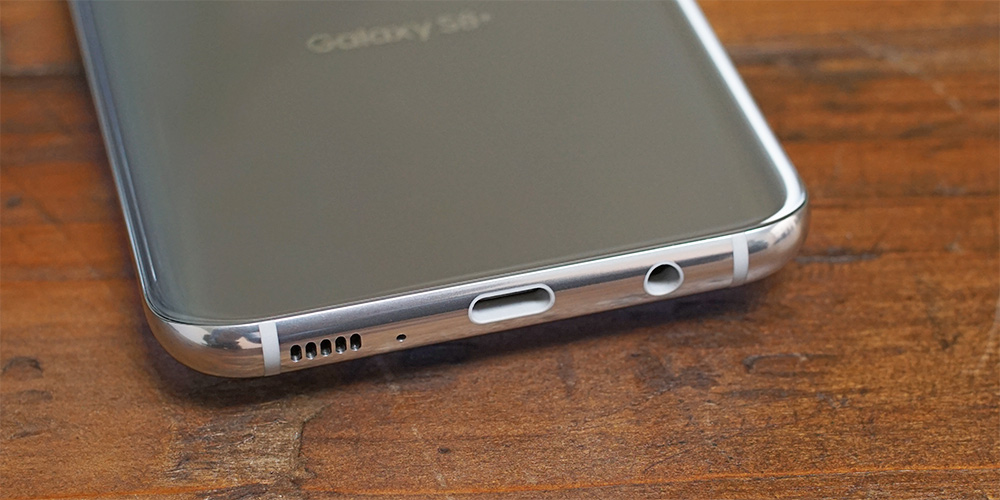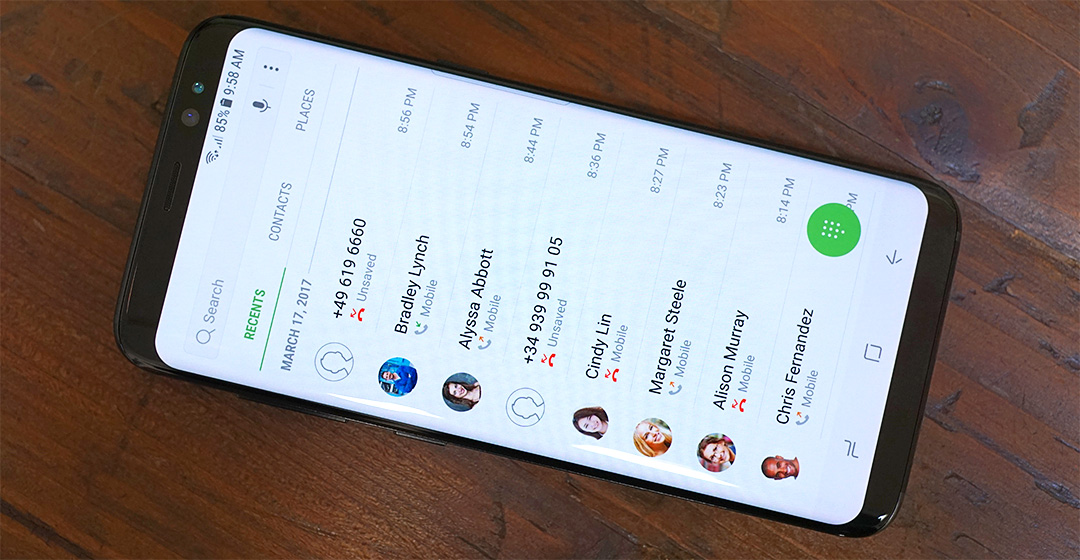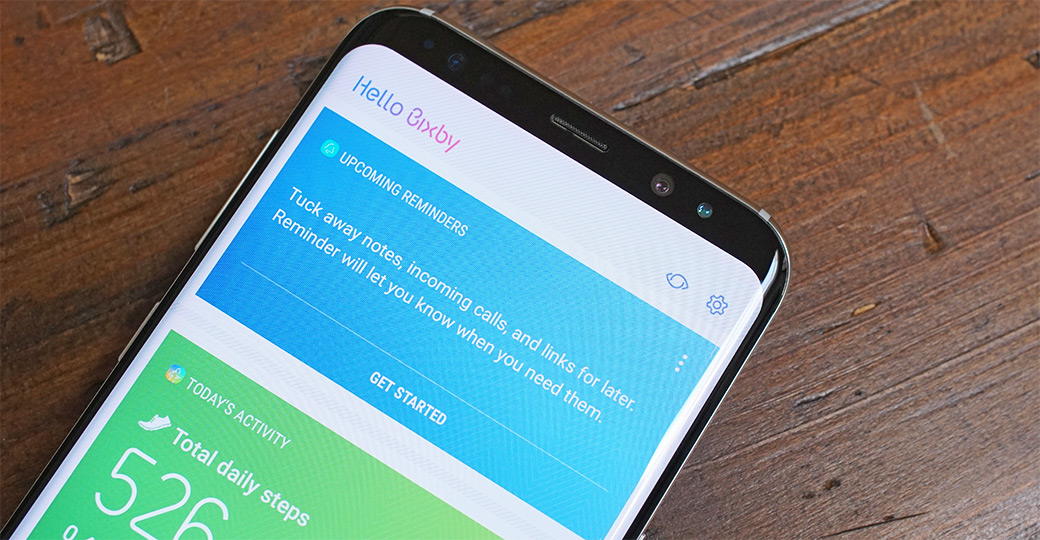Hands On With Samsung's Galaxy S8 and S8+: Taller Screens and Slimmer Bezels
by Matt Humrick on March 29, 2017 11:00 AM EST- Posted in
- Smartphones
- Samsung
- Galaxy
- Mobile
- Galaxy S8

Samsung officially unveiled the latest Galaxy devices at its Unpacked event in New York today. Previous Galaxy phones were part Porsche 911 Carrera, with an easily recognizable curvaceous style, and part Swiss Army knife, bristling with technology and features. This analogy holds true for the 5.8-inch Galaxy S8 and 6.2-inch Galaxy S8+, which share the same design DNA as the previous two generations.
The new phones’ aluminum frame remains sandwiched between edge-to-edge Corning Gorilla Glass 5, with curved sides on the front and back. The curved rear glass makes the phones easier to pick up and more comfortable to hold just as they did for the S7 and S7 edge, while the curved front glass—now standard on both S8 models—adds some visual flair.
There’s not much difference between the S8 and S7 along the sides either. The USB Type-C port on the bottom is flanked by a 3.5mm headphone jack and a single downward-firing speaker. The microSD/NanoSIM combo tray still resides on the top, and the thin power button is still a bit more than halfway up the right side. The only differences between new and old lie on the left side, where the volume buttons have been combined into a single rocker and a dedicated button for launching Samsung’s Bixby assistant makes its debut. Unlike the power button, I found myself occasionally pressing the Bixby button accidentally when picking up the smaller S8.
The most significant change is found up front, however, and it’s one that impacts both form and function. The Galaxy S8 and S8+ adopt Samsung’s new “Infinity Display” that stretches the screen vertically but not horizontally, deviating from the traditional 16:9 aspect ratio. The result is a QHD+ SAMOLED display with a 2960x1440 resolution and an 18.5:9 aspect ratio that’s very similar to the 18:9 aspect ratio display LG is using in its G6. Both Samsung and LG cite market research for this new display direction: People want larger screens that can show more content, but they also want phones that are useable with one hand and can fit in their pocket. The taller screen fits more content, so less scrolling, but keeps the phone narrow, so it’s easier to wrap your hand around.
Both S8 phones incorporate another emerging design trend: rounded display corners. Where LG’s G6 is using an LCD panel that actually has rounded corners, it appears Samsung is using a rounded bezel to cover the S8’s still sharp-cornered display. This avoids the aliasing that’s evident in the G6’s corners, producing a much smoother, nicer looking effect. While my time with the S8 was limited, it appears that TouchWiz and Samsung’s apps were redesigned to account for the rounded corners: Backgrounds extend the full height of the display and visual elements are still displayed along the top and bottom edges without getting cut off. Third-party apps, however, find their vertical dimensions constrained to the purely rectangular portion of the display, with the status bar above and the navigation bar below taking on black backgrounds.
The S8 and S8+ are also the first phones to receive the UHD Alliance’s Mobile HDR Premium certification that ensures a mobile device meets the minimum requirements for playback of 4K HDR video. This means that both S8s are capable of rendering at least 90% of the DCI-P3 color gamut, have a dynamic range of at least 0.0005-540 nits, and support a 10-bit display pipeline.
To keep the overall size of the phones in check, the S8/S8+ and G6 have dramatically reduced the bezel area around the taller screens. Samsung claims a screen-to-body ratio of 83% for its new Galaxy phones, less than the 91.3% of Xiaomi’s Mi MIX concept phone, but impressive nonetheless, especially considering how much hardware is located in the S8’s upper bezel. Besides the usual earpiece and proximity/ambient light sensors, there’s a new 8MP front-facing camera with f/1.7 lens and Smart AF that uses facial recognition for accurate focusing when taking selfies. There’s also an IR LED and IR camera for the iris-scanning security feature that made its debut on the ill-fated Galaxy Note7.
Shrinking the size of the lower bezel required relocating the fingerprint sensor to the back. Instead of placing it below the rear camera like we see on most other phones, Samsung places it next to the flush-mounted camera, which is less than ideal. Both the camera and the sensor are surrounded by a raised lip and are similar in size, making it difficult to locate the sensor by feel, and if your finger misses the sensor, you end up with a nice fingerprint on the camera lens. On the smaller S8, this issue may be mitigated with practice, but the problem is worse for the S8+. Being taller, it places the camera and sensor further from the lower edge, making it very difficult, if not impossible, to reach the sensor when holding the phone with a natural grip. Even with my larger-than-average hands, I struggled to reach the sensor without shifting my grip. I suspect people will turn to the iris scanner or the new face unlock feature, which uses the front camera for facial recognition after pressing the power button, to overcome the poor fingerprint sensor placement. The physical home button and capacitive navigation buttons, iconic Galaxy design features, have also been evicted in favor of the slimmer bezel, replaced by onscreen controls.



















208 Comments
View All Comments
royalcrown - Thursday, March 30, 2017 - link
"The curved rear glass makes the phones easier to pick up and more comfortable to hold"...Solution >= don't have tiny bitch hands. Pwn.
3ogdy - Thursday, March 30, 2017 - link
I don't agree with the fact that one could touch the camera when the intention was to touch the fingerprint scanner. It has edges and, holding the phone in the right hand allows the index finger to reach the fingerprint scanner first. It's actually the best position it could've had.I don't agree when you say it's EASIER to grab the phone from the table if it's curved. It's HARDER to do so because without proper edges (closer to 90º angle) it's easier for the fingers to slip while trying to grab the phone. Right after reading that I've tried doing it with an SGS3 and the more curved area (screen facing the table, downwards) makes it more difficult to grab the phone. It's not an advantage, it's a problem, albeit a really negligible one.
It's disappointing that Samsung is still prioritizing thickness over battery life. That's so true. I couldn't give a damn if the phone was thicker - as long as it had a bigger battery. The problem is non user-replaceable batteries cannot be replaced with aftermarket higher capacity ones that just increase the thickness of the phone and come with their own cover. Thank God for microSD.
Matt Humrick - Thursday, March 30, 2017 - link
Have you held a Galaxy S8/S8+ in your hand? I have. The fingerprint sensor is more difficult to reach, especially so if you're left handed. The S8+ is even worse, because the sensor is even higher on the back, making it a real stretch to even get your finger up that high. There is not a noticeable difference in feel between the camera and sensor either, other than the camera is larger.Have you ever tried to pickup a Galaxy S6 edge from a table? Very difficult. The rounded corners on the front leave you with almost no aluminum edge to grip, and the thin edge basically sits flush with the table because of the flat back. The rounded back edges on the S7 and S8 allow the meaty part of your fingertip to wrap around the edge and get under the phone just enough to help you get a better grip.
Belard - Thursday, March 30, 2017 - link
On top of that. It still seems stupid to make a phone with a glass back. They still crack. Apple stopped doing glass 3 generations ago.Notmyusualid - Sunday, April 2, 2017 - link
@ BelardWhilst I'm not a conspirists, I do believe anything to sell more phones (understand from a companies' point of view), is fine by them.
The more delicate / fragile a phone is, is a boon for repair & replacement business.
SydneyBlue120d - Thursday, March 30, 2017 - link
Everything seems to be really good, however I'm much more interested in the Sony Xperia XZ Premium.arayoflight - Thursday, March 30, 2017 - link
Matt, s8 uses IMX333, not IMX260. Correct it please.Matt Humrick - Thursday, March 30, 2017 - link
Source?lilmoe - Thursday, March 30, 2017 - link
These guys have an AIDA64 screenshot.https://www.sammobile.com/2017/03/30/samsung-is-so...
sharath.naik - Friday, March 31, 2017 - link
No bezel + Case pointless. No bezel - case pointless. I understand thin bezel but wrap around screen? why? no one in the right mind will not have to buy a case for this. And please samsung I need a upgrade to note 4, that is keeping everything same (replaceable battery, sdcard, removable back) but adding Fingerprint reader and updated processor that's it and I am reserving one. May be a thinner bezel, but no wrap around bezel please.